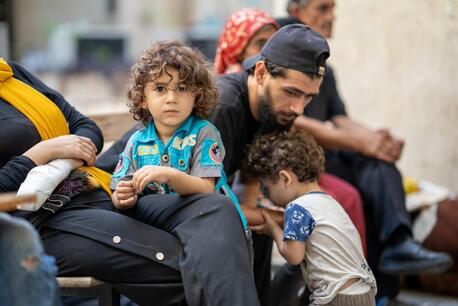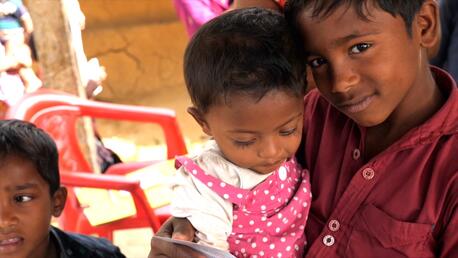
Quality and Equality: Education for Rohingya Refugee Girls
How UNICEF is helping make education more inclusive in Rohingya refugee camps in Cox's Bazar, Bangladesh.
Rahima Akhter* would do anything to protect her children in the Rohingya refugee camps in Cox's Bazar, Bangladesh, where they live in a temporary dwelling tightly packed among strangers. She worries especially about her daughter's safety and dignity. Better to keep 14-year-old Nurkolima* at home, Akhter used to think, than let her go to school where she might be the target of unwanted male attention. If keeping Nurkolima safe meant sacrificing her education, then so be it.
Akhter was herself the victim of sexual harassment as a girl in Myanmar. When her parents heard about it, they considered it such a scandal, they married her off as quickly as possible. The memory, the humiliation of it all, haunts her still.
Rohingya refugee camps in Cox's Bazar, Bangladesh are home to more than 400,000 school-age children
"When a girl reaches puberty, she shouldn't be allowed to go outside," says Akhter, echoing a point of view held by many Rohingya refugee parents. "Boys and girls shouldn't spend time in the same classroom because it can lead to bad things."
Five years have passed since a brutal military crackdown forced more than 700,000 Rohingya Muslims out of Myanmar's Rakhine state and into what has become the world's largest refugee settlement, in Cox's Bazar, Bangladesh.
Today, the crowded camps are home to 1 million Rohingya refugees, including more than 400,000 school-age children, half of whom are girls. Learning is vital for their well-being and future prospects, yet girls often face greater barriers to education than boys, due to the social and religious norms that limit the time they may spend outside the home and who they associate with.
UNICEF and partners have been working closely with the Rohingya refugee community to convince parents like Akhter of the lasting benefits of sending their adolescent daughters to school.

Adolescent girls cheer for one of their classmates after she reads aloud in a UNICEF learning center in Rohingya refugee Camp 15, Cox's Bazar, Bangladesh. © UNICEF/UN0690297/Spiridonova
Barriers to education for Rohingya refugee girls
Education for Rohingya refugee children is provided by 3,400 learning centers — 2,800 of which are supported by UNICEF — spread out across the camps. At the centers, students learn English, Burmese, mathematics, science and life skills. Eighty percent of Rohingya children between the ages of 6 and 11 are enrolled in learning centers, with enrollment equally high among girls and boys.
But the gender gap becomes prominent as girls grow older, with a significant number of Rohingya girls dropping out once they reach puberty, between the ages of 12 and 14.
UNICEF and partners recently went door-to-door, meeting with Rohingya families to better understand the factors preventing girls from continuing their education at learning centers.

Evidence suggests that more girls go to school and stay in education longer if they are taught by female teachers. Given the shortage of qualified teachers among the Rohingya refugees in Cox’s Bazar, recruiting and training new female teachers, and continuing the professional development of existing teachers, are priorities for UNICEF. © UNICEF/UN0690295/Spiridonova
Parents said that sending adolescent girls to learning centers was not culturally appropriate. They believe girls of this age are too old to learn and should not be seen in public spaces with boys. In addition, many parents do not see the value of educating girls, who are expected to help their mothers at home before getting married and having families of their own — unlike boys, who are encouraged to go out into the world to earn a living.
"Girls over 12 years old are supposed to stay home. They take care of younger siblings and cook food for the family," Akhter says, referring to the gender stereotypes that still hold sway in her community.
Rohingya parents also cited concerns about the safety of their adolescent daughters in the camps as a reason for keeping them home. Yet girls who stay at home are more vulnerable to the risks of child marriage, early pregnancy, gender-based violence and sexual exploitation.
Creative approaches to learning for female students
Since Nov. 2021, UNICEF and partners have been piloting a project to provide Rohingya refugee children with formal and standardized education based on the national Myanmar curriculum. As part of the Myanmar curriculum pilot, UNICEF supports girls-only lessons, an acknowledgement of the fact that many Rohingya parents prefer this for their daughters.
In 2019, I started going to a learning center but stopped in the same year. My body had changed, and I didn't feel comfortable being in the same room with boys anymore. Madam came and told us that, starting this year, the learning center has a separate class for girls. My mother liked this new arrangement and allowed me to resume my studies. — Rajuma, 13
UNICEF is also working with the community to mobilize female Rohingya chaperones to accompany girls to and from the learning centers.
Classes in UNICEF-supported learning centers are team-taught by one Bangladeshi teacher from the host community and one Burmese language instructor from the Rohingya community.
There is evidence of the positive effects of female teachers on improving girls' learning. Given the shortage of qualified teachers among the Rohingya refugees, recruiting and training new female teachers, as well as continuing the professional development of existing teachers, are priorities for UNICEF.
"We put a lot of effort and resources to prioritize girls' safety, protection and learning," explains Dr. Ezatullah Majeed, Chief of the UNICEF Field Office in Cox's Bazar. "The issue is multilayered, and we need to consider cultural factors and initiate education activities that are accepted and supported by the Rohingya community."
Support from the community is vital
To ensure lasting change, buy-in from members of the community is essential.
UNICEF has not only mobilized hundreds of Rohingya volunteers to speak to their friends and neighbors about the importance of educating girls, it has also enlisted the help of 300 religious leaders. Armed with a megaphone, they are often seen walking through the camps spreading the message that all girls have the right to go to school to build a better future for themselves.
Efforts like these are transforming the lives of girls like Nurkolima.
"I hadn't sent my daughter to a learning center before. Now I understand the importance of studying," her mother says. "It's too late for me, but I want a good future for my girl. She needs to be a good student so that she can become a teacher, or find any other job. Boys learn, why can't girls do the same? It's good for them."
UNICEF has been on the ground in the refugee camps in Bangladesh since Day One. Your contribution can help UNICEF continue to support and protect Rohingya refugee children. Please donate.
The bipartisan Keeping Girls in School Act is designed to harness the power of U.S. Government to address the barriers that prevent girls from getting an education. Urge your Members of Congress to support legislation that empowers girls around the world.
*Names have been changed to protect identities.
Top photo: A girls-only session for Rohingya refugees in a UNICEF learning center in Cox's Bazar, Bangladesh. © UNICEF/UN0690296/Spiridonova
HOW TO HELP
There are many ways to make a difference
War, famine, poverty, natural disasters — threats to the world's children keep coming. But UNICEF won't stop working to keep children healthy and safe.
UNICEF works in over 190 countries and territories — more places than any other children's organization. UNICEF has the world's largest humanitarian warehouse and, when disaster strikes, can get supplies almost anywhere within 72 hours. Constantly innovating, always advocating for a better world for children, UNICEF works to ensure that every child can grow up healthy, educated, protected and respected.
Would you like to help give all children the opportunity to reach their full potential? There are many ways to get involved.




